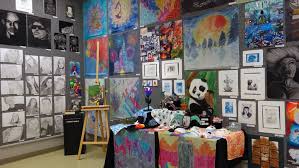Art has always found a way to break free from the confines of museums and galleries. But street art takes this rebellion to a whole new level. It transforms city walls, abandoned buildings, and even sidewalks into vibrant canvases, creating a dialogue with the public in an unmediated, often provocative way.
Street art encompasses a vast array of styles and techniques, from intricate stencils and bold murals to playful wheatpastes and subversive guerrilla installations. More importantly, it represents a diverse range of movements, each with its own distinct voice and message. Let’s delve into a few of these movements that have used the urban landscape as their platform for social commentary, artistic expression, and community engagement.
Stencil Revolution: A Message Multiplied
Stencil art exploded onto the scene in the late 20th century, offering a simple yet powerful way for artists to leave their mark. Pioneers like Blek le Rat in Paris and Shepard Fairey in New York City utilized stencils to create instantly recognizable imagery that could be quickly reproduced and disseminated across cityscapes. This rapid proliferation allowed artists to bypass traditional gatekeepers like galleries and reach a wider audience.
The most obvious impact of the stencil revolution was its ability to spread political messages. Artists like Keith Haring and Barbara Kruger employed bold visuals and concise slogans to critique social and political issues. Haring’s iconic figures, often accompanied by cryptic symbols, questioned war, consumerism, and environmental degradation. Kruger’s confrontational texts, emblazoned on public walls, challenged societal norms and power structures.
Beyond political commentary, stencil art also served as a tool for self-expression and community building. Artists like Banksy, whose playful yet satirical stencils have become synonymous with street art, used stencils to create whimsical characters that often reflected a sense of humor and defiance. In many cities, stencil art became a way for local artists to showcase their work, fostering a sense of camaraderie and shared purpose.
Reclaiming the Streets: Yarn Bombing and Guerrilla Gardening
Street art can take many forms, not all of which involve paint or spray cans. Enter yarn bombing, a movement that transforms the urban landscape with vibrant displays of colorful yarn. Pioneered by artists like Magda Sayeg in the early 2000s, yarn bombing adds a touch of whimsy and playfulness to public spaces, often adorning street signs, trees, and even entire buildings.
More than just a playful intervention, yarn bombing carries a deeper message. It allows participants, often non-professional artists, to reclaim neglected or forgotten spaces. The softness and tactile nature of yarn can create a sense of comfort and community in areas that might otherwise feel harsh or unwelcoming. Additionally, yarn bombing often involves collaboration, bringing people together in a shared creative endeavor.
Another movement that reimagines the urban landscape is guerrilla gardening. This practice involves the unauthorized planting of flowers, vegetables, and other vegetation in neglected or abandoned areas. Guerrilla gardeners reclaim concrete jungles by injecting them with life and color. Their actions highlight the importance of green spaces in densely populated cities and serve as a call to action for more sustainable urban planning.
Landscape Art: A Window to the World
Landscape art, throughout history, has served as a window into humanity’s relationship with the natural world. From the detailed realism of Renaissance painters to the evocative impressionism of the 19th century, landscape art has captured the beauty and grandeur of nature, as well as the ever-changing moods of the environment. These depictions not only offer a visual escape but can also reflect cultural values and anxieties about the natural world.
Importance of Art: Beyond Aesthetics
Importance of art extends far beyond aesthetics. It serves as a powerful tool for communication, allowing us to express emotions, ideas, and experiences that might be difficult to articulate with words alone. Art can challenge societal norms, spark social change, and preserve cultural heritage. Furthermore, engaging with art, whether creating it or simply viewing it, can foster empathy, creativity, and critical thinking skills. In a world increasingly dominated by technology, art offers a vital space for human connection and reflection.
From Protest to Empowerment: Muralism and Community Engagement
Muralism, the creation of large-scale artwork on walls, has a long and rich history. However, in recent decades, it has become an increasingly powerful tool for community empowerment. Community murals often depict the history and culture of a particular neighborhood, fostering a sense of pride and belonging amongst residents. Artists work alongside community members to create murals that reflect their shared experiences and aspirations.
Muralism can also be a potent tool for social justice. Artists like Keith Haring and Judith Baca have created large-scale murals that address issues of racism, poverty, and inequality. These murals not only raise awareness but also serve as a rallying point for communities fighting for change.
The process of creating a mural itself fosters a sense of community engagement. Residents of all ages and backgrounds can participate in the creation, fostering a sense of ownership and investment in the public space. The completed mural becomes a symbol of unity and collaboration, showcasing the power of art to transform not just walls but also communities.
Conclusion
Street art movements push the boundaries of what art can be and where it can be found. They utilize the urban landscape as a canvas for social commentary, artistic expression, and community engagement. From the potent messages of stencil art to the transformative power of murals, these movements demonstrate the unique ability of street art to spark conversations, challenge the status quo, and breathe life into our cities.
FAQs
How can I get involved in street art?
There are many ways to get involved in street art, depending on your interests and skill level. You can:
- Support local street artists: Attend art walks, purchase their prints, and follow them on social media.
- Learn a street art technique: Take a stenciling or wheatpasting workshop.
- Volunteer with a community mural project: Many organizations use art to revitalize neighborhoods.
- Create your own street art (legally): Find designated walls or participate in street art festivals. Always get permission from the property owner before creating art on a public surface.
Where can I find great street art?
Street art is a global phenomenon, but some cities are particularly renowned for their vibrant street art scenes. These include:
- Berlin, Germany
- Melbourne, Australia
- Rio de Janeiro, Brazil
- New York City, USA
- London, England
Many cities offer street art tours, which can be a great way to discover hidden gems and learn about the stories behind the art.
What is the future of street art?
Street art is a constantly evolving art form. With the rise of social media, artists now have new tools to share their work and connect with a global audience. Additionally, there’s a growing recognition of the positive impact street art can have on communities. As cities continue to grapple with issues like gentrification and social inequality, street art is likely to play an increasingly important role in shaping public spaces and promoting social dialogue.
Feel free to submit more guest posts through Links Building Servcies - Best Prices. Buy Author Account / 1$ Guest Post Here





















